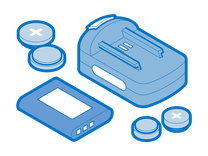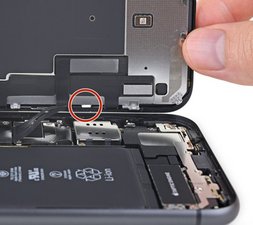Introduction
So, your phone is stuck in an infinite boot loop. Every time the Apple logo comes around again, or you get a successful boot, you think it's going to be okay. But then, your hopes are dashed when the screen goes black... again. This is one of the most difficult iPhone issues to pin down, due to a wide variety of causes. But that just means more chances at getting a fix!
First Steps
Before undertaking any of the more time-consuming solutions below, there are a few fundamentals to give a go.
- Connect to a known functional, or different charger. Your phone may not be getting enough energy to complete boot.
- Perform a force restart. Consult the Guide for your model if you are not familiar with this process.
- If you can get into the OS, check for any software updates. This also includes app updates.
Causes
During the course of using your phone, something in the ones and zeroes that makes it run might have been lost or changed in a way that renders your device unusable. This is commonly a result of a botched update, an app that conflicts with functionality, or even a malicious piece of software.
To attempt to correct this, perform a reinstall of the operating system. If your phone will stay booted for long enough, you can try this from within the settings menu. Otherwise, you'll need to get it into recovery mode to initiate this process.
- Try to update first.
- If the update is unsuccessful, time to assess the state of your backups. If you're certain you have a recent backup or are willing to sacrifice your data to regain the use of your phone, proceed to restore. This will erase any data presently on your phone. If you would rather not erase the device, skip restore and try some of the hardware fixes below first.
If the update or restore fails with an error message, document it. Now might be a good time to visit the Answers forum, where you can get more personalized help. Be sure to mention the error message in your question!

- 5 minutes - 1 hourVery easy
Getting warnings that your device is low on storage? It’s easy to ignore, but computerized devices also need some free space to operate properly. Think of it like your sock drawer. You can squish any number of additional pairs of socks in, but eventually your drawer will stop closing. It’s possible your phone is in this “can no longer function as intended,” state.
- Try the force restart steps outlined at the beginning of this page again. A few times even. If you’re lucky, this may allow you the one successful boot you need to get in and clear out some of the five hundred blurry pictures of your puppy chasing a paper bag around the yard.
- If this doesn’t work, ultimately you’re going to need to reset your device. Especially if you have gotten recent low storage warnings. If it’s not already in recovery mode, you’ll need to get it there and restore your device.
- This may be the underlying fault if you have received errors 14, 78, or 1110 when processing a recovery mode update.

- 5 minutes - 1 hourVery easy
The charge port and the connected interior flex cable are common points of failure on all iPhone models. It is prone to wear and easily exposed to the environment. This leads to inconsistent charging, and the inability to maintain power for long enough to boot properly.
- Inspect your charge port using a flashlight for better visibility. It is common for bits of lint or rubbish to get caught in the port and compress with repeat charging. To verify, check the fit of your cable. Does the lightning plug sit flush with the bottom of the phone? It should.
- If there is debris in the port, use a toothpick or other non conductive probe to clear it. Insert the point straight to the back and gently scrape out residual debris. Be mindful of the pins.
- If a toothpick is too large, try splitting the tip with a knife. Half a toothpick can usually reach the most recessed crevices of a charge port.
- A phone that only charges at particular angles, or intermittently in general, may need a new charge port assembly.
- Note: Be sure to source replacement charge part assemblies from reputable vendors or splurge for the higher quality part. Substandard third-party replacements are rampant.
We are likely all aware that all rechargeable batteries degrade over time. This can lead to poor battery life. But batteries can fail in any number of other ways, which can lead to unexpected restarts.
- Check your battery health. Under Settings > Battery > Battery Health Does it say Service?
- By Apple’s guidelines, anything with a capacity of less than 80% needs battery service, though it can detect other failures as well. If it says Service here, a new battery is a reasonable start.
- If it says your battery is performing as expected, see the breakdown of battery usage.
- Search for signs of battery swelling. Is there localized screen discoloration on the left side (or right side for series 12 and newer iPhones). Is the screen lifting along one side?
- Replace the battery with a new one if there are any indications of failure. Exercise caution when handling the battery. Lithium-ion batteries can be hazardous if they are damaged.

Find compatible replacement parts for your iPhone. All parts and fix kits are backed by the iFixit Quality Guarantee.
Starting with the iPhone X, Apple rolled out a sensor check routine as part of normal function. Any sensor in a predetermined list needs to send out a signal every 180 seconds, or the phone will restart as a protective measure.
- This is almost certainly the cause if your phone boots normally, but will only stay on for three minutes before restarting.
- Check the logs, a place iPhone owners seldom tread.
- Under Settings > Privacy > Analytics and Improvements > Analytics Data. Scroll through for any entries with panic or panic.full in the name.
- Find the panic string.
- Missing sensor errors will show as thermalmonitord or watchdog timeout. If your panic string is different, look for keywords to give you clues. Refer to the expanding page of panics. Or post in the answers forum for the community to look at!
- For a watchdog timeout or thermalonitord panic, read past the panic string to find the missing sensor.
- Reseat the connectors for the indicated parts. Inspect them for signs of damage or malfunction. Replace if necessary.
| Missing Sensor | Location | Likely Issue |
|---|---|---|
| PRS0 - Barometer | On the Charge Port Assembly | Charge Port Assembly or its connector on the Logic Board |
| Mic1 - Bottom Microphone | ||
| Mic2 - Rear Microphone | Power Button Cable, Camera Flash Cable | Power Button Cable, Camera Flash Cable or its respective connector on the Logic Board |
| TG0V | Battery sensors, most likely for temperature and voltage | Battery or its connector on the Logic Board, Charge Port Assembly on 11 Pro and Pro Max, charging circuitry on the board level. |
| TG0B |
Ultimately, nearly every signal within an iPhone is going to, or coming from within the board. Disruption of these necessary communications to connected hardware can also cause restarting.
- Boot up on a minimal hardware configuration,
- Open up the device and disconnect anything that is not necessary for you to power on the phone. For most iPhones, this means a battery, a charge port and a display (so you know it’s booting). If you’re not sure how to open your phone, check the Guides Page.
- Connect a charger or USB cable to prompt the phone to boot.
- If the phone boots normally on the minimal setup, reconnect parts one by one. Be suspicious of the home button and front facing camera cables
- You can narrow down from the minimum configuration by eliminating the charge port and using the power button flex cable instead. Or eliminate the screen by connecting to a PC and verifying it stays connected.
The best laid plans sometimes end with your phone in the toilet. Even if your phone seems perfectly fine, it might not be. It only takes one tiny droplet of water in the wrong place to wreak havoc on a circuit board.

- If there is any chance your phone may have gotten wet, check the liquid damage indicator.
- Eject your SIM tray and use a flashlight to peek inside. The liquid contact sticker is on the underside of the display. It can be tricky to spot, but it will be red if it has contacted liquid and white if it's dry.
- A red sticker isn't a guarantee that your phone is loaded with last night's cocktail, but it warrants further investigating. Open your device using the appropriate Guide and make use of the iPhone Liquid damage Guide if need be.
- If you subscribe to the leave it in rice myth—reevaluate! it might save your phone.

- 1 hourModerate
The logic board is the hub for the vast majority of an iPhone's functionality. Any number of the small components on the board may have failed or become damaged and is a safe assumption of cause if nothing else on this page has worked.
- Check for obvious signs of a board issue - burned or cracked components, liquid residue, corrosion, or bend. If there are signs of liquid the iPhone Liquid Damage Guide might help.
- Replacing the logic board with a new one is often the most practical solution for a DIYer in this position.
- If you’re feeling especially curious, the tiny bits and chips on the board can be repaired by microsoldering. It is an art unto itself, but a worthy endeavor for those who are adventurous. Interested? Check out this intro! Jessa’s YouTube channel is also fantastic and has loads of real-time repairs. If you can't do this sort of repair yourself, you may be able to find a local shop who can!

- 1 hourModerate

Find compatible replacement parts for your iPhone. All parts and fix kits are backed by the iFixit Quality Guarantee.







